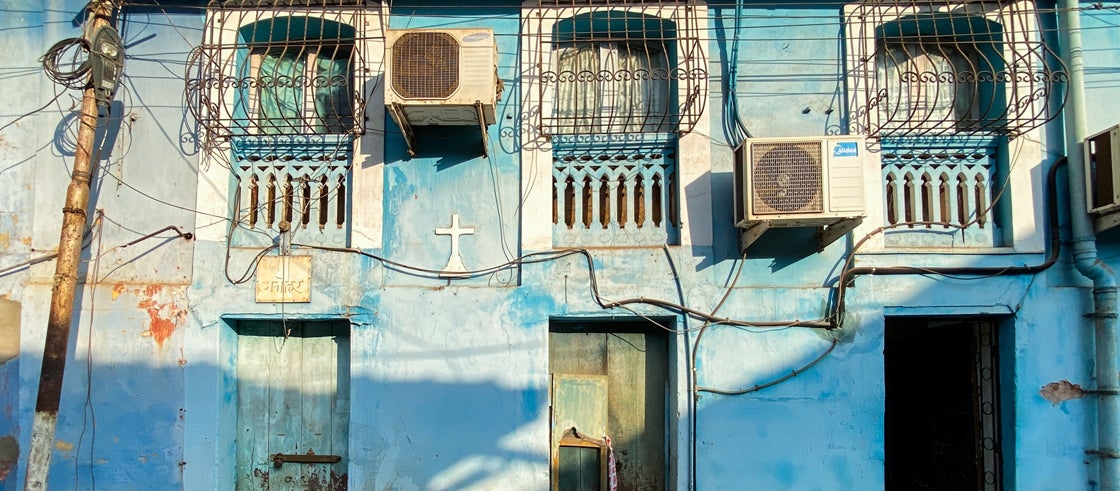 Shutterstick / balajisrinivasan
Shutterstick / balajisrinivasan
A scorching heatwave swept across northern India this past week, with temperatures climbing to highs of 45 degrees Celsius. This ongoing 2023 heat wave was made more likely by climate change, as South Asia continues to experience rising temperatures, with record-breaking heat waves that are longer, hotter, and more frequent.
Emerging research highlights how heat not only causes deaths and lowers productivity, but also disrupts children’s learning and deepens educational inequities. In other words, safe and comfortable indoor temperatures are not a luxury but a development imperative.
In South Asia, indoor temperatures of buildings with tin roofs often exceeded outdoor temperatures, with a difference of up to 4 degrees Celsius.
However, existing buildings in the region tend to exacerbate heat risks, with heat-trapping materials and inadequate shade, ventilation, and insulation. A recent study found that, in South Asia, indoor temperatures of buildings with tin roofs often exceeded outdoor temperatures, with a difference of up to 4 degrees Celsius. In addition, indoor air pollution is a significant health risk in the region, with indoor concentrations of pollutants often exceeding outdoor levels.
In order to better protect and enable its people in a changing climate, South Asia needs buildings that provide safe, comfortable indoor temperatures and air quality. Cooler buildings also offer the benefits of reductions in energy costs, potential power outages, and the use of climate-warming refrigerants.
Our recent report "Improving Building-Level Thermal Comfort and Indoor Air Quality in South Asia" outlines cost-effective and energy-efficient cooling and ventilation solutions in the region.
Harness the massive potential of passive cooling: Passive cooling, or free natural cooling without the use of mechanical cooling systems like air conditioners, should be deployed as much as possible at the early stages of the design process. For instance, a quick solar exposure analysis at negligible costs can identify a building orientation and layout that minimizes unnecessary heat gain and reduces the energy needs of a building by 5-20 percent, depending on the building’s location.
Integrate old traditions and new technologies: Newer technologies should be integrated thoughtfully with older traditions. Traditional buildings often incorporate effective cooling and ventilation traits not reflected in modern designs, such as shading that blocks direct sunlight or building materials that absorb and store heat during the day and release it at night when temperatures are cooler. On the other hand, simple low-cost IT solutions such as carbon dioxide, temperature, and humidity sensors can help quickly adjust ventilation and cooling processes according to real-time needs.
Calibrate cooling temperature setpoints: There is no one “right” cooling temperature setpoint. Many modern buildings in South Asia are designed for and utilize mechanical cooling systems to achieve indoor temperatures of 24 degrees Celsius. However, studies show that many South Asians are comfortable at higher temperatures than typically assumed by building designers. A one-degree Celsius increase in the cooling setpoint can reduce energy usage in buildings in a hot climate by 6-10 percent and may lead to even higher energy savings when combined with additional measures, such as the use of air circulation devices.
Foster cooling and ventilation behavior change: The role of occupant behavior is important. With more awareness of and engagement with the importance of cooling and ventilation, people can optimize day and night building operations to take advantage of free natural cooling and air flow. Depending on the location of the building in South Asia, natural ventilation can be used for about 15-40 percent of the day to promote air flow and reduce the need for mechanical cooling systems.
Maximize impact per dollar of cooling and ventilation measures: Cooler buildings are not necessarily that much more expensive. The figure below identifies cooling and ventilation measures that maximize the impact per dollar by comparing incremental costs and operational energy savings. Passive measures such as orientation, shading, natural ventilation, and cool roofs have some of the largest energy savings with low costs (incremental costs of 0-1 percent). Notably, certain active systems such as air circulation and evaporative cooling systems are also highly cost-effective (incremental costs of up to 3 percent).
Heat and air pollution pose a growing threat to people in South Asia. There are cost-effective, energy-efficient cooling and ventilation solutions available now to ensure safe and comfortable indoor temperatures and air quality. The region should invest in cooler buildings to better withstand and protect people from rising temperatures in a changing climate.





Join the Conversation